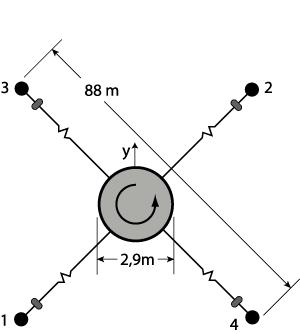
Online Help EFW for Dummies Related |
1. EFW: The Basic Hardware
|
 The EFW experiment has four wire booms mounted on each of the Cluster
spacecraft. The distance from the satellite centre to the boom tip is 44
m. The satellite spins at a rate of once every four seconds, which keeps
the booms taut. The
actual sensor is a sphere, 8 cm in diameter, at the end of each boom.
The EFW experiment has four wire booms mounted on each of the Cluster
spacecraft. The distance from the satellite centre to the boom tip is 44
m. The satellite spins at a rate of once every four seconds, which keeps
the booms taut. The
actual sensor is a sphere, 8 cm in diameter, at the end of each boom.In electric field mode, these booms are operated in two pairs at 90 degrees to each other: pair 1-2 and pair 3-4 (see diagram). Electric fields are inferred by measuring the potential difference between the sensors at either end of a pair. Having 2 pairs means 2 components of the electric field are visible. The reason for mounting the probes at the end of long booms is twofold. First, a larger separation between the probes leads to a larger potential difference, which is easier to measure. Second, the long booms separate the sensors from the spacecraft potential and the photoelectron cloud around the spacecraft. There are a few other pieces of hardware which are necessary. Hardware for measuring and pre-processing the data and for deploying the wire booms (which are stowed for launch) is located where the booms meet the spacecraft. Hockey puck-shaped units 1.5 meters from the probe spheres (see diagram) house pre-amplifiers, and allow a thinner wire to be used close to the sensor. Finally, the 1.5 meters of cable on the other side of the puck (toward the satellite) is a "guard". It can be electrically biased so as to deflect spacecraft photoelectrons away from the sensor spheres. |
Okay, you're thinking; this is really simple. There's a couple of probe spheres, which are sitting in the plasma. They're conductrors, so they'll be sitting at the same potential as the plasma, we can just measure the voltage between them to get the electric field. It's just a big voltmeter, right?
Well, not quite. The problem is that when you put a metal sphere into a sunlit plasma, it doesn't sit at the same potential as the plasma around it...
Next page
Up to table of contents